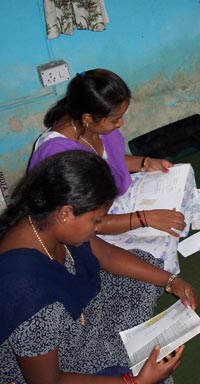Rationale and Goals of Research Project
Arland Thornton,
William G. Axinn,
Dirgha Ghimire
Population Studies Center
Survey Research Center, and
Department of Sociology
The University of Michigan
Ann Arbor, Michigan 48106
Developmental Idealism and Family and Population Dynamics in Nepal: Rationale and Goals of Research Project
This is a pilot research project concerning “Developmental Idealism and Family and Population Dynamics in Nepal”. This project is a collaborative endeavor that will create and test research instruments for measuring developmental idealism, collect data from a pilot study of respondents, and evaluate the effectiveness and usefulness of the research protocols and data. This project is a collaborative endeavor between the University of Michigan and the Population and Ecology Research Laboratory in Nepal.
This research and training project grows directly out of Thornton’s 2001 PAA presidential address, “The Developmental Paradigm, Reading History Sideways, and Family Change” (Demography, November 2001), which has been expanded into a book-length manuscript. Briefly (and roughly), one major thesis of this paper is that the developmental paradigm–a model of natural, universal, necessary, and directional change–dominated the social sciences from the 1700s through the middle 1900s. This paradigm suggested that all societies progressed through the same stages of development. The speed of advancement was believed to vary so that at any one point in time one could observe societies at different developmental levels. These scholars believed that the most advanced societies were in northwest Europe and among the northwest European diaspora, while other societies were viewed as occupying less advanced positions on the pathway of development. Scholars using the developmental paradigm believed that they could use this cross-sectional variation to infer the nature of developmental trajectories across time. That is, they read history sideways from the cross-sectional data they observed by assuming that at sometime in the past the most developed nations had been like their less developed contemporaries and that at some point in the future the least developed nations would become like their more advanced neighbors.
These scholars observed that the family systems of northwest Europe were very different than those in many other parts of the world. They found societies outside northwest Europe that were generally family-organized, had considerable family solidarity, and were frequently extended. Marriage was frequently universal and often contracted at a young age. These societies also had considerable authority in the hands of parents and the elders, arranged marriages, and little opportunity for affection before marriage. They also had gender relationships that the scholars of the day interpreted as reflecting low status of women. By contrast, northwest European societies were observed to be less family organized, to be more individualistic, to have less parental authority, and to have weaker intergenerational support systems. They also had more nuclear households, less universal marriage, older marriage, and more affection and couple autonomy in the mate selection process. They also perceived women’s status as higher in northwest European societies. With the developmental paradigm and reading history sideways methodology it was easy for generations of scholars to conclude that the process of development transformed family systems from the traditional patterns observed outside of northwest Europe to the developed patterns within northwest Europe. They believed that sometime before they wrote in the 1700s and 1800s, there had been a family transition that had changed European families from being like the traditional world outside of northwest Europe to being like the modern families of northwest Europe.
These scholars also observed that the social and economic systems of northwest Europe were different from those in many other parts of the world. They observed that northwest Europe was more industrial, urban, and educated than many other parts of the world; it also had higher levels of knowledge, consumption, geographic mobility, secularism, democracy, and religious pluralism. They also observed that there had been actual increases in many of these dimensions of northwest European social and economic life. They made the inference that the unique northwest European family system was causally connected to the northwest European social and economic system–as both a cause and effect.
In Thornton’s presidential address he argued that these ideas permeated the scholarly literature from the 1700s through the middle 1900s. However, in the second half of the 1900s a number of studies that used the northwest European historical record to read history from the past to the present rather than from cross-sectional variation revealed that there was no such historical transformation in northwest Europe. This new wave of scholarship revealed that the modern family systems of northwest Europe observed in the 1700s and 1800s had been in place for centuries rather than being the product of recent development. This discovery discredited the idea that societies progressed over time from the traditional family systems outside of northwest Europe to the modern family systems of northwest Europe. It also cast doubt on the idea that modern family systems were the products of modern socioeconomic systems, while strengthening the belief that modern family systems were causal forces producing socioeconomic development.
A second major thesis of Thornton’s presidential address is that the developmental paradigm, reading history sideways, and the conclusions of generations of social scientists about family change helped to create a set of propositions–developmental idealism–that have had an enormous effect on the history of family and demographic change. This package of developmental idealism included a set of ideas identifying the good life, a means for evaluating various forms of human organization, an explanatory framework identifying the good life as both cause and effect of various social patterns, and statements about the fundamental rights of individual human beings. Thornton argues that these ideas and beliefs have been especially powerful in changing family and demographic structures and relationships around the world.
There are four main propositions of developmental idealism. The first is that modern society is good and attainable. By modern society Thornton means the dimensions of social and economic structures identified by generations of scholars as developed–including, for example, being industrialized, urbanized, highly educated, highly knowledgeable, and wealthy. The second proposition of developmental idealism is that the modern family is good and attainable. By modern family Thornton means the aspects of family identified by generations of earlier scholars as modern, including the existence of many nonfamily institutions, individualism, nuclear households, intergenerational independence and autonomy, marriages arranged by mature couples, courtship preceding marriage, and a high valuation of women. The third proposition is that a modern family is a cause and an effect of a modern society. Finally, the fourth proposition of developmental idealism is that individuals are free and equal and that social relationships are based on consent. The argument is that these four propositions provide a system of beliefs that can guide a broad array of family and demographic behaviors and relationships, and increases or decreases in their acceptance can lead to changes in family and demographic behavior.
In Thornton’s presidential address he assembled a wide array of evidence to support these two general theses. The first thesis was supported from a review of the paradigms, methodologies, and interpretations of several generations of social scientists. The second thesis was supported by a review of existing empirical data concerning social change in many parts of the world, documenting how developmental idealism influenced family and demographic change.
Unfortunately, the empirical evidence Thornton assembled to support the theses of his presidential address was not collected for the purpose of testing the actual influence of developmental idealism. Therefore, many of his conclusions were based more on indirect evidence than direct evaluation with empirical data designed for that purpose. The goal in the coming years is to launch a program of research that collects data specifically to evaluate the ideas formulated in Thornton’s presidential address. That program of research has the following goals.
First, to evaluate the extent to which ordinary people believe and accept the propositions of the developmental paradigm, the methodology of reading history sideways, and the conclusions of generations of social scientists about family and demographic change. Although these ideas and conclusions have been discredited by recent scholarly research, we expect that they are widely believed in many populations around the world. Direct documentation of the extent of this belief would be helpful.
Second, evaluate the extent to which ordinary people believe and accept the four propositions of developmental idealism. Do ordinary people believe that modern society is good and attainable, that modern family is good and attainable, that a modern family is a cause and an effect of a modern society, and that individuals are free and equal, with social relationships based on individual consent. The goal here is not to decide whether these propositions are true or false but ascertain the extent to which they are accepted.
Third, examine the social forces influencing the degree of belief and acceptance of the developmental paradigm, reading history sideways, the conclusions of social scientists about family and demographic change, and developmental idealism. What are the individual experiences that affect one’s beliefs in these ideas? What are the social forces that change the distribution of these beliefs in the population? What produces variation in these beliefs?
Fourth, examine the consequences of these beliefs for family and demographic behavior. Here the goal is to examine systematically the hypothesis that variation in these beliefs has consequences for demographic and family behavior. Also of interest is the hypothesis that changes in these beliefs are associated with changes in family and demographic behavior.
That is the long-run goal of this program of research. This pilot project on “Developmental Idealism and Family and Population Dynamics in Nepal” is the first step in that program of research. Our goal here is to translate the ideas associated with the developmental paradigm, reading history sideways, the conclusions of scholars about family change, and developmental idealism into a set of questions that can be asked of respondents in surveys. Although these questions will be formulated first in English, they will be translated into Nepalese for administration in Nepal. Focus groups and cognitive testing will also take place in Nepal to check understanding of the questions and concepts. We will implement these survey questions and protocols in a modest pilot study in Nepal. We will print questionnaires, train interviewers, recruit and interview respondents, code the data, create a data set, and conduct and report preliminary analyses. The primary goal is the creation and evaluation of the survey questions, protocols, and resulting pilot data.















